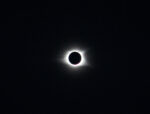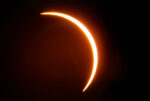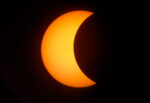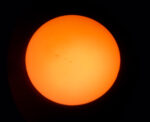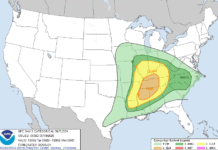
The eclipse was visible across all but a very small portion of Northeast Georgia.
The Great American Solar Eclipse has come and gone, leaving in it’s path countless people who were amazed by it’s beauty.
A large crowd turned out to the Total Eclipse of the Park in Clarkesville, and they were treated to beautiful weather. That weather is what I’d like to talk about.
Temperature drops were reported across the region during the eclipse, ranging anywhere from just a few degrees to 10+º. In Clarkesville, my thermometer reported a temperature drop from 93.7º pre-eclipse, to 82.9º just after totality, for a drop of 10.8º. The official reporting station in Cornelia saw a drop from 89º to 81º. Commerce saw a slightly larger drop from 90º to 81º. Gainesville fell from 89º to 84º, with Jasper falling from 88º to 80º. Just across the border the Andrews-Murphy airport fell from 88º to 77º. Temperatures drops were greatest along the line of greatest totality, but impressive region-wide.
The other impressive occurrence was the massive decrease in cloud cover during the height of the eclipse. Around 1PM, a large area of cumulus clouds began to develop across the entire area, with the majority of these parking over the mountains. As the time of totality drew near, we saw most of these clouds dissipate due entirely to the decrease in temperatures. As temps dropped, the instability needed to sustain these clouds disappeared, allowing almost all of Northeast Georgia to have clear skies during the duration of the eclipse. Portions of Rabun County were the only areas to miss out on totality, primarily in areas around Sky Valley.
From an astronomy perspective, several prominence were visible around the sun. These appeared as small red areas next to the moon’s shadow from the naked eye. The most distinct of these areas was on the bottom left of the sun’s disc. If you noticed these, you were seeing areas of gas jetting up from the sun’s surface. The corona was dispersed into three distinct beams, and telescopes revealed large loops caused by the sun’s magnetic field.
NASA’s DISCOVR satellite watched the shadow cross the Earth from over 1,000,000 miles away, as seen in the video below, courtesy of NASA.

The next time the moon’s shadow will fall on the Earth will be on July 2, 2019 over the southern Pacific ocean and portions of Chile and Argentina. The next solar eclipse visible from Habersham will come on October 14, 2023 when the sun will become about 60% covered. This will be followed quickly by the April 24, 2024 total eclipse that will traverse the US from north to south, covering around 80% of the sun here in Northeast Georgia. If you missed out, no worries! I’ve got you covered with both photos and videos taken from our event at Pitts Park down below.


